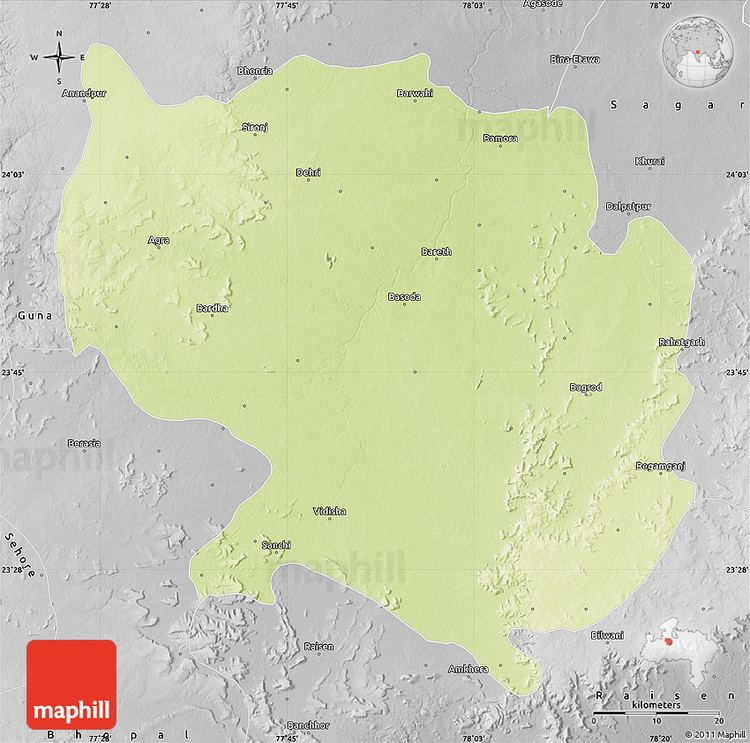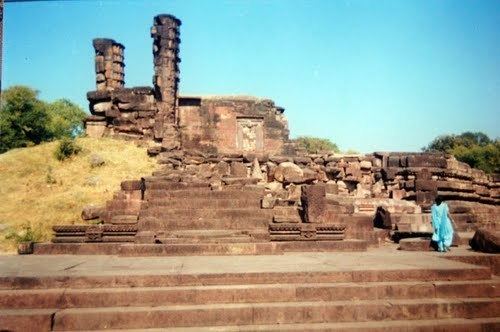Country India Language spoken District Vidisha | ||
 | ||
Map of Vidisha
Vidisha is a city in the state of Madhya Pradesh, India, located near the state capital Bhopal. Vidishā was the administrative headquarters of Bhelsa, or Bhilsa, during the Medieval period.
Contents
- Map of Vidisha
- Geography
- Demographics
- Historic places and monuments
- History
- Emergence as Bhelsa
- Notable persons
- Transport
- Education
- References

Geography
Vidisha is located at 23.53°N 77.82°E / 23.53; 77.82. It has an average elevation of 424 metres (1391 feet).
Demographics
As of 2011 India census, Vidisha had a population of 155,959. Males constitute 53.21% of the population and females 46.79%. Vidisha has an average literacy rate of 86.88%, higher than the national average of 74.04%: male literacy is 92.29%, and female literacy is 80.98%. In Vidisha, 15% of the population is under 6 years of age.
Historic places and monuments
Near the eastern edge of the old town are the remains of a large temple of the late Paramara period known as the Bijamaṇḍal. The building was probably started in the second half of the 11th century. That it was never finished is shown by carved niches and unfinished architectural pieces found round the base of the temple plinth. On top of the plinth is a small mosque made using pillars, one of which has an inscription dating probably from the time of king Naravarman (circa 1094-1134). It is a devotional inscription revering Carccikā (i.e. Cāmuṇḍā), of whom he was a devotee. The miḥrāb suggests the mosque was constructed in the late 14th century. To one side of the Bijamaṇḍal is a store house of the Archaeological Survey of India containing many sculptures collected in the neighbourhood. A step-well of the 7th century is in the same campus and has, beside the entrance, two tall pillars with Kṛṣṇa scenes. These are the earliest Kṛṣṇa scenes in the art of central India. Bijamandal Temple at Vidisha is one of massive dimensions comparable with Konarak in Orissa.
Lohangi Pir is a rock formation in Vidisha District that derives its name from Shaykh Jalal Chishti, a saint who was locally known as Lohangi Pir. This small domed building is a tomb, which has two Persian inscriptions on it. One of the inscriptions dates back to 1460 BC, while the other dates back to 1583 BC. The tank and a large bell-capital dating back to the 1st century BC can be seen on the nearby hill. Near the tomb, there are the remains of a medieval temple that survived as a pillared crypt. These are dedicated to Goddess Annapurna. Lohangi is a large rock right in the heart of Vidisha in walking distance of railway station.This is religious as well the historical importance place in the region.
Udaygiri is less than 10 kms from Vidisha town. It is a series of at least 20 caves, containing both Hindu and Jain sculptures from the Gupta Era, sometime between the 4th and 5th century AD. It is basically a small hill where intricate sculptures have but cut out of the rocks.
Maladevi Temple is a grand Portal of Ninth century AD, situated on the eastern slope of a hill and built on a huge platform cut out of the hillside and strengthened by a massive retaining wall, Maladevi temple is in fact imposing and astonishing building, provides a panoramic valley view, in Gyaraspur, about 40 Kms away from District Vidisha, Madhya Pradesh, India, which can be accessed through NH-146.
Khamba Baba, also known as Heliodorus Pillar, is a stone column, which was constructed in 110 BC. This stone column was erected by the Greek ambassador of the Indo-Greek King Antialcidas, who came to the court of Bhagabhadra, the Sunga king. Dedicated to Lord Vasudeva, this column was constructed in front of the temple of Vasudeva.
Khamba Baba is situated about four KM away on Vidisha-Ganj Basoda SH-14, from District Vidisha, Madhya Pradesh and located on the Northern Bank Of The Vais River. Indeed Khamba Baba is 20 feet and 7 inches tall stone Pillar, which is commonly known as Kham Baba. This pillar has two inscriptions in the language of that period that is Brahmi and Prakrit, which describes that Haileo Darris who erected this pillar as the Garuda Stambh to pay homage to Lord Vasudeva means Lord Vishnu.
Hindola Torana as Hindola means a swing and Torana is a arched gate, is a magnificent art work of 9th-century or medieval period, situated in Gyaraspur about 40 Kms away from District Vidisha, Madhya Pradesh, can be accessed via NH-146. This is a developed, ornamental and decorated arched gate made of sand-stone. On its both pillars Lord Vishnu's ten incarnations are engraved. Near it four carved and sculpted pillars and beams seems to be ruins of Trimurthy temple set on one raised platform, as Lord Shiva, Lord Ganesha, Goddess Parvati and their servants are sculpted on these pillars and beams.
Hindola Torana with its two upright pillars and cross-beam has a truly indicative name. All the four sides of the two lofty pillars are carved into panels with insertion of the ten incarnations of Vishnu. So it may be an entrance gate for the Lord Vishnu's Temple or Of Lord Shiva and also may be of Thirumurthy. And two structures are completely in ruin as Archaeological Survey Of India has not given much informations about these ruins. In my view it would have been a grand temple complex.
Bajramath Temple is situated in Gyaraspur, about 40 Kms away from District Vidisha, Madhya Pradesh, on NH-146 behind the Sub-Judicial Magistrate and Tehsildar's Office Gyaraspur, temple is facing to the East and significantly it was a Hindu Temple, later it was transformed to Jain Temple. Indeed it is just opposite to the Hill on which Maladevi temple is situated.
Dashavtar Temple is situated on the north of the local lake, where ruins of a group of small Vaishnava shrines can be found. These small Vaishnava shrines are popularly known as Sadhavatara Temple. The temple comprises a large open pillared hall, in which the pillars are dedicated to the ten incarnations of Vishnu. These pillars date back from 8th to10th century A.D. Towards the western bank of the lake lies the ruins of sati pillars that date back to 9th or 10th century A.D. One of these pillars are carved with four sculptured faces that depict a seated group of Hara-Gauri.
Girdhari Temple, which is known for its sculptures and fine carvings, is a popular attraction in Sironj. The shrines of Jatashankar and Mahamaya that belong to the ancient time are located close to this temple. Jatashankar Temple is situated 3 km towards the south-west of Sironj in forest area. On the other hand, Mahamaya Temple is situated 5 km south-west of Sironj.
Udayeshwara Temple, located in Udaipur village of the Basoda Tehsil, is one of the most prominent Hindu shrines in the region. The inscriptions found in this temple suggest that the Udaipur Town was founded by the Parmara King Udayaditya during the 11th century A.D. Other inscriptions found at the temple suggest that Parmara King Udayaditya construed this temple and dedicated it to Lord Shiva.
History
The town is situated east of the Betwa River, in the fork of the Betwa and Bes rivers, 9 km from Sanchi. The town of Besnagar, 3 km from present-day Vidisha on the west side of the river, became an important trade centre in the 6th and 5th centuries BCE, under the Shungas, Nagas, Satavahanas, and Guptas, and was mentioned in the Pali scriptures. The Emperor Ashoka was the governor of Vidisha during his father's lifetime. His Buddhist Empress Vidisha Devi who was also his first wife was brought up in Vidisha. It finds mention in Kalidasa's Meghdoot.
Emergence as Bhelsa
Besnagar was abandoned in the 6th century. It came into prominence again as Bhelsa during the medieval period. It became famous for the temple of Sun god Bhillasvanin. It was ruled by the Later Gupta king Devagupta and Rashtrakuta king Krishna III. The name is first noted in an inscription of 878 AD by a merchant Hatiaka of Paravada community. The 12th century Tri-shashthi-shalaka-purusha-charitra mentions an image of Bhillasvamin at Vidisa, along with a copy of Jivant Swami buried in the sand. Minhajuddin's Tabaqat-i-Nusiri states that the temple was destroyed by Iltutmish in A D. 1233-34.
In 1293, Allauddin Khilji of the Delhi Sultanate sacked the city as a general of Sultan Jalaluddin. It has been described as a very difficult loot which shows that Vidisha had an importance in the medieval era. In 1532 Bhilsa was sacked by Bahadur Shah of Gujarat. It thus, passed on to the Malwa Sultans and then to the Mughals and the Scindias.
Notable persons
Born in Vidisha Kailash Satyarthi won the 2014 Nobel Peace Prize.
Shivraj Singh Chouhan is the current chief minister of Madhya Pradesh.
Transport
Vidisha is a railway station on the Delhi-Chennai, Delhi-Mumbai main line of the Central Railway, at a distance of 54 km from Bhopal, the capital of Madhya Pradesh. Sanchi on the Jhansi-Itarsi section of the West Central Railway and Bhopal to Bina triple electrified broad gauge lines, from Bina to Katni double electrified Lines, Vidisha 102 km from Bina, and Vidisha, 9 km from Sanchi, are more convenient.
Education
Vidisha is a home to a range of colleges and schools. Vidisha has a large student population and is a popular educational centre in central India. Most primary and secondary schools in Vidisha are affiliated with the Central Board of Secondary Education (CBSE); however, quite a few numbers of schools are affiliated with M.P. Board as well. Trinity Convent School is a very popular school in Vidisha. S.A.T.I college is one of the oldest and popular Engineering College in central India. Vidisha has many other big and small science and arts colleges.
